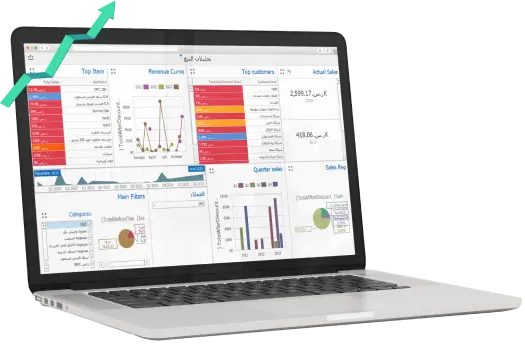Reviewing the cash and credit sales documents cycle and ensure that it matches the company's policy.
- Tracking the cash sales and cash sales at Branch and make sure that all cash invoices have been collected or there is approval from the management to delay collecting this invoice.
- Reviewing A/R trial balance and review the collections and make sure that they have been recorded in the subsidiary ledger and subsequently posted to the trial balance
- Monitoring the debt reports and sending them to the sales department, preparing the weekly and monthly collections plan, and monitoring the arrears.
- Monitoring of notes receivable that are handed over to the sales reps with serial numbers, reviewing the serial numbers, and make sure that the amounts in the notes receivable are all recorded on the accounts receivable software.
-Tracking the product price list on an ongoing basis, as well as the discount policy and discount rates in the case
- Preparing Detailed Sales Report (sales of each item, each group of similar items, quantities and values, and at the level of each period relatively and comparing them with previous periods and also analyzing them at the level of branches and sales territories and knowing the relative weight of each item, the quantity of sales by the value of sales to the total items)
- Sales by Customer Report, selecting the active customers and most withdrawn items for each customer
- The sales ratio per customer to total sales by customer
- Notes Receivable Report
- Item Sales Report over more than one period to determine the impact of price changes
- Sales Return Report and items most likely to be returned
- Sales Order Report by Sales Rep
-When generating each report, the comparisons are made for the previous period similar to it
Accounts Receivable Reconciliation
One of the main duties and responsibilities of any accounts receivable accountant or the accounts receivable department is to create reconciliations, the reconciliations that may be monthly, quarterly or semi-annually at least and at the end of the year, annual reconciliations must be created with accounts receivable balances to ensure that the balances are matching and to prevent manipulation by the sales reps in the collections and delivery of the goods to customers
Reconciliations are created to ensure that the accounts receivable balance matches the balance in the accounts receivable books
Accounts receivable department printing the balances of trial balance of accounts receivable in the period for which a reconciliation is required
After reviewing the balances and make sure that all the journal entries and invoices for each period were completed
A reconciliation form is created for each customer for the period in which the reconciliation are to be created, in which the customer code and the balance to the end of the period, and it is written in it (Please reconcile your debit balance worth **************)
Printing the reconciliation forms and submitting them to the sales department to create the reconciliations
And the customer must stamp on the reconciliation that the balance is matching and also getting an account statement to prevent that the sales rep forges the seal in the companies that deal with retailers or small businesses but large companies are in a difficult situation and prefer to getting an account statement with the seal on the reconciliation to tightness control over sales and the balances confirmation
In the case that the customer mention that the balance is not matching in the period in which creating the reconciliation
First we must creating the reconciliation between the balance and the accounts receivable balance in one period and make sure the opening balance is matching, or if it is not matching, must knowing the difference from the previous reconciliation, Is this an old difference since years or was it a difference at the time of recording in the previous period, meaning the invoice was created and recorded in the books on 30/6 and recording it in the books in July that is the idea
In the case that the balances between me and the customer do not match, so we select the period in which creating the reconciliation and printing the customer's account statement with an account statement request from the customer and start to return the invoices that I have with the invoices delivered to the customer and their date with the values and make sure that are matching, in the case that there is a difference between the value of the invoice I have with the value of the invoice in the accounts receivable books, selecting the invoice so that it as reference when the reconciliation of the rest invoices is completed and selecting the reason for the difference between the non-matching invoices, Is there a mistake in the recording or is there a discount, meaning you select what is the reason for the differences between the invoices, and review the invoices, the goods issue note, and delivery note to make sure that the invoice is matched with the goods issue note and delivery note to ensure that the invoice is matched with the goods issue note and returns with the customer are reviewed and to make sure that the quantities and values are matching
The most important matter is to review the collections and make sure that all the collections received from the customer are matching, and this one of the matters for the sales reps that they can manipulate with it
It is possible that an invoice or payment recorded in a period of time I have and the customer in a previous or later period, and this one of the matters that we must take into consideration
Accounts Receivable Documents Cycle
The accounts receivable documents cycle differs from one company to another according to the nature of the activity and according to the type of customers, for example, if the company is industrial or commercial, and its customers are companies also, in the documents cycle is an inquiry sent from the customer
The company sends a quotation, and in the case that the customer agrees to quotation, quantities, prices, payment method, method of shipment and delivery of the goods. The sales department or finance department, according to the nature of business in the company, creating a sales order and then generating the invoice and delivery note after the credit department approves the customer’s credit limit and sends it to the warehouses for the goods issue, the storekeeper creates a goods issue voucher that matches the delivery note, and the customer signs the delivery note
In other companies, often in the food companies or pharmaceutical companies, the sales rep creates a custody voucher for the quantity of the goods, and at the end of the day creating a liquidation of the custody and creating the cash invoices by the quantities that issued and a sales items return that returned to the warehouses
The sales invoices are either cash sales, credit sales. As for the cash invoices must be paid before the goods issue from the company’s warehouses, or collected on the same day or within a few days, according to the company’s policy and the nature of its products, meaning that the storekeeper does not deliver the goods to the customer until after and the accounts receivable accountant must tracking the cash invoices daily and tracking their collection
The accounts receivable documents cycle may differ from one company to another in some details according to the type, size, and nature of the company and according to the work system
Accounts Receivable Journal Entries
Accounts Receivable Journal Entries in the cash sales and credit sales
Assume your company sold 100,000 worth of goods plus a 14% VAT to Al-Salam Company
The journal entry is as follows
|
Account |
Debit |
Credit |
|
Accounts Receivable (Al-Salam Company) |
140,000 |
|
|
Sales |
100,000 |
|
|
VAT Output Account (100,000 * 14%) |
14000 |
The previous journal entry is in the case of credit sales, but in the case of cash sales, the journal entry would be Cash A/c Dr. instead of Receivable A/c Dr.
In the case of companies that have branches and exhibition and event sales, an account is opened to monitor the cash sales (e.g., Cash Sales at Alexandria Branch)
And when creating a cash invoice in the branch or exhibition, the journal entry in the accounting software is as follows
|
Account |
Debit |
Credit |
|
Branch Account |
XXX |
|
|
Sales |
XXX |
Of course, at the end of the day, the cash is reviewed in the treasury and checked that there is no deficit, and then a journal entry is created
|
Account |
Debit |
Credit |
|
Cash on Hand |
XXX |
|
|
Branch Account |
XXX |
The cash balance must be matching, meaning it is equal to zero, meaning that all cash sales are collected unless there is an exception from the senior management
The second journal entry in the sales, whether in cash or credit, is the cost of goods sold (COGS) according to any method of inventory pricing
|
Account |
Debit |
Credit |
|
COGS Expense |
XXX |
|
|
Inventory/ Finished Goods Inventory |
XXX |
It is the journal entry of the goods issue from the company's warehouses
The payment and collection journal entry in the case of the credit sales
|
Account |
Debit |
Credit |
|
Bank/ Cash on Hand |
99,000 |
|
|
W/H Tax deducted |
1000 |
|
|
Accounts Receivable |
100,000 |
Withholding and collection tax - is a tax deducted by the buyer (the customer) from the supplier's invoice, it is a
1% in the case of the supply of raw materials, 3% in the case of services, and 5% in the fees of the liberal professions, and the buyer then provides to the Tax Authority on tax form 41 for taxes of withholding and collection
Cheques Receivables (clearing accounts)
First, upon receiving a check from the customer, the check is still in the company's treasury
|
Account |
Debit |
Credit |
|
Notes Receivable |
XXX |
|
|
Accounts Receivable |
XXX |
And when sending the check to the bank
|
Account |
Debit |
Credit |
|
Cheques Receivable |
XXX |
|
|
Notes Receivable |
XXX |
In the case that the returned check for any reason
The journal entry is as follows
|
Account |
Debit |
Credit |
|
Notes Receivable |
XXX |
|
|
Cheques Receivable |
XXX |
The first journal entry also reversed the return of the debt to the accounts receivable
As for if the check was collected at the bank
|
Account |
Debit |
Credit |
|
Bank / Cash on Hand |
XXX |
|
|
Cheques Receivable |
XXX |
There is another method found in some companies
Upon receiving check
|
Account |
Debit |
Credit |
|
Cheques Receivable |
XXX |
|
|
Accounts Receivable |
XXX |
When the check is sent to the bank or the cash collection
|
Account |
Debit |
Credit |
|
Bank / Cash on Hand |
XXX |
|
|
Cheques Receivable |
XXX |
The balance of the cheques receivable that appears in the trial balance or the general ledger account must contain an analysis of the check's due date and its value and the balance shall be matching to prevent errors










